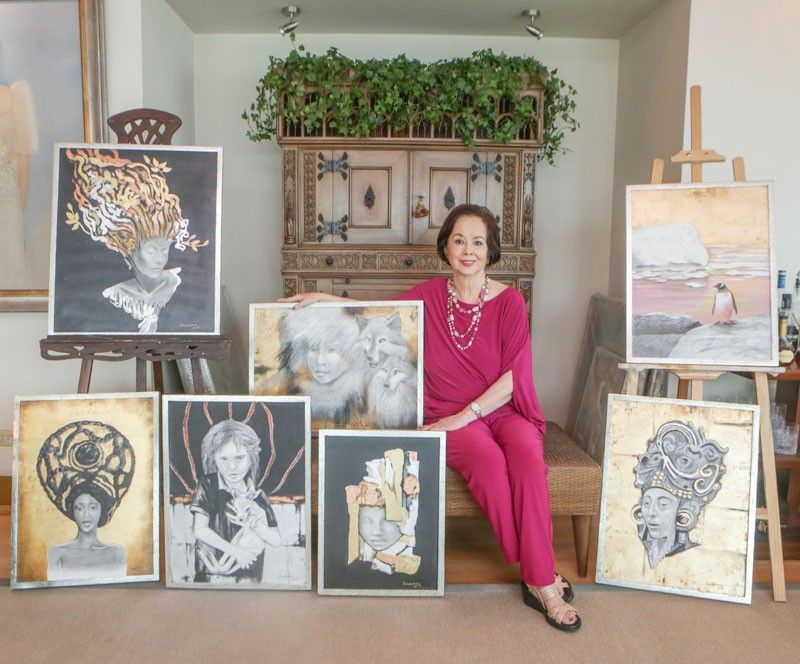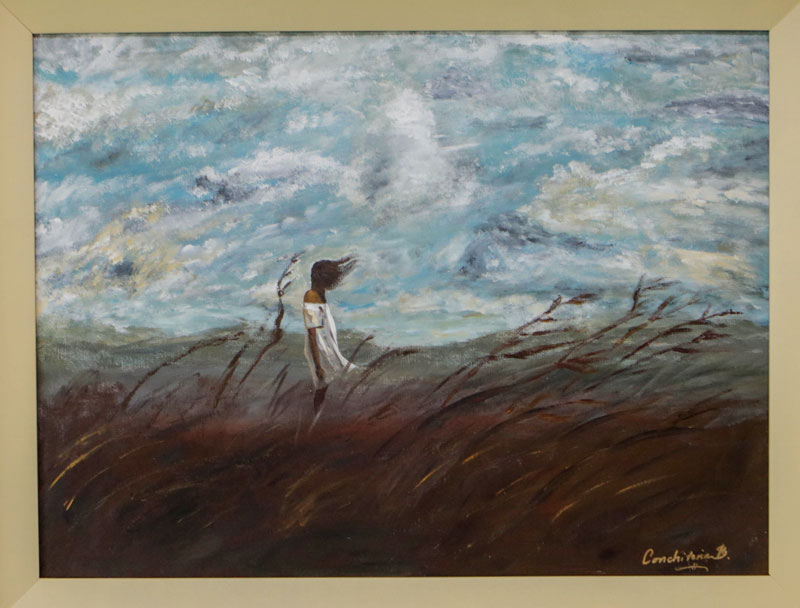Conchitina Sevilla-Bernardo: ‘My anti-aging secret? Painting with my heart and soul’

She belonged to that gracious, courteous age when men always showed proper respect to women, when it was rude to laugh loudly or shout in public, when good manners and right conduct were basic common sense, when women knew not to cross their legs in public or were even careful, literally speaking, to dot their i’s and cross their t’s.
But of course, some of us remember Conchitina Sevilla, she of the porcelain skin, beautiful baby doll face, and gentle, impeccable manners. At 15, the petite teen was the country’s youngest fashion model traveling the world and walking the ramp for the country’s top couturiers, among them the revered Ramon Valera and Pitoy Moreno.
Today — as though she’d seen it all, been there and done that with all her heart — she started experiencing irregular heartbeats. “I didn’t even know that something was wrong with my heart,” she begins to relate as she sits with us in her cozy condo in Makati. “I was just having a conversation with a former classmate when she asked, ‘Chitang, what’s wrong with you? Did you fall asleep?’ For a few seconds, I didn’t know I fell asleep as my heart started to beat so fast.”
The End of The Line or The Beginning of A New Life?
Conchitina reveals, “In my case, I had extreme tachycardia (irregular heart rhythm where the heart beats faster than normal). That’s why I would doze off and had a flat line. My doctor said three seconds would not kill, but I could be crossing the street, falling down and hitting my head, so he strongly recommended a pacemaker. My father had the sick sinus syndrome so he also had a pacemaker. I got it at 72. My father died at 80. I said well, it’s the end of the line (which turned out to be the beginning of a new life, but more on that a heartbeat later). I was feeling really, really low.”
Right after her operation, still feeling depressed, she joined the prayer group meeting she regularly went to and one of her friends told her to take up tai chi at the Sunshine Place, a recreation center and a second home for the elderly run by SM’s Felicidad Sy Foundation.
“Why tai chi?” she repeats our question. “Because, with tai chi, you remember the moves so it works not just your muscles but your mind as well (so) it keeps away Alzheimer’s. It’s not strenuous, it’s very low-impact, but you perspire heavily because you’re working every muscle in your body.”
Conchitina recommends, “Brisk walking is the best thing you can possibly do for your heart. Swimming is also good, but I just walk across the pool.”
One day, after her tai chi class, she thought of going to the second floor of this happy place for seniors tucked away on Jupiter Street in Makati. There she met art teacher Fidel Sarmiento, president of the Art Association of the Philippines, with some of the elderly students he personally mentored.
Conchitina approached Prof. Fidel and asked him, “Could you really teach me?”
Her First Art Heartbreak

“Tempest Brewing”: This was a work Conchitina did in her first year of painting (she’s now in her third year), just after her heart surgery. “I was feeling really, really low,” she says. “My husband likes it!”
She’ll never forget the heartache of her first brush with the paintbrush. “When I was young, in my early 30s, I enrolled in Chinese brush painting for one year. I bought the ink, every brush imaginable, I really invested in painting. But one day, my professor came up to me and said, ‘Do you take drugs?’ I replied with a vehement ‘No.’ Then he asked, ‘Do you drink?’ Another vehement ‘No.’ Then he told me to my face, ‘You know, Mrs. Bernardo, you should look for another hobby.’ It seemed I didn’t know back then that I had a slight tremor in my hands. When you’re doing brush painting, it’s a stroke at a time. But he put it to me in such a way that he discouraged me immensely. He could have been nicer and should have said, ‘Mrs. Bernardo, look for another type of art where you could work your hands.’ He simply dismissed me so the trauma was hanging over my head.”
The insecure artist wannabe asked Prof. Fidel again, “Matuturuan nyo ba ako? Tinanggihan ho ako ng Chinese painting teacherko at matanda na ako (Could you teach me? I was turned down by my Chinese painting teacher and I’m already old).”
Prof. Fidel’s heartfelt reply: “There’s an artist in every person. You just have to let it out.”
And so, this determined student worked at her art every single day. “It’s not great, but it’s not bad,” she says with a demure smile. “I can go from 10 in the morning to 6 in the evening just painting. First, you pick a subject, then you begin to sketch. With every stroke, your mind is totally focused, never mind if your fingers are crooked, your knees hurt, or your heart is skipping a beat. When the painting is done, you’re simply amazed and you tell yourself, ‘My God, I didn’t know I could do something like this!’ And I thank maestro Fidel Sarmiento for unselfishly teaching me from zero.”
Conchitina remembers that one of her first priceless works was not a painting but a sketch. “I was brought up by the Assumption nuns and every Lent, we had to give up something that we really loved and I used to give up Coke or patis. The nuns really worked you, they did a job on me. Two years ago, during Holy Week, I said I was going to give up painting, which I really loved, for 40 days. But after two weeks, I talked to God and asked Him, ‘Can I sketch? It’s not painting (it’s drawn with a material called graphite which is crystallized carbon).’ Professor Fidel was teaching me how to do portraits and he taught me how to use graphite. When my sketch was finished, I bargained with God again: ‘Can I put black?’ I bought copper, bronze, gold and silver leaf in Spain. So, I put it there and brought my work to Fidel. I asked him, ‘Sir, do you like this?’ He told me that it was going to be the style I should develop because it was not common.”
Today, Conchitina devotes her art to the cause of the endangered species of birds, which her forthcoming one-woman exhibits (a one-night invitational at Frabelle Salcedo and two weeks at Sunshine Place, Aug. 1-14) will highlight. “The little birds I painted for my solo exhibits are all critically endangered, like this little flowerpecker, of which there are just 100 left in the region of Cebu, talking to the deer. Their habitat is being destroyed and these birds end up as a meal on the dining table. The spotted deer is also endangered. It roams the Visayan Islands and is hunted down by human predators for its meat, tapang usa.”
Conchitina is simply drawn to the deer, which she says is her spirit animal. “Each of us has one. If you look within yourself, you will find the animal that you feel a kindred spirit to. For me, it’s the fawn (a young deer). It’s vulnerable, it’s got a certain look of wonder.”
Proceeds from the sale of her paintings will go to the San Lorenzo Ruiz Home for the Elderly. “Why the elderly? Because I’m elderly and I know the pains of being old, and these nuns pick up the abandoned elderly. I met them when I was president of the Makati Medical Center Foundation.”
‘Psalm 42’ and Some Lessons
Conchitina is so attached to her work titled “Psalm 42,” she will never sell it. “The psalm says, ‘As the deer longs for running water, my soul longs for you, my God.’ I told my daughter Lia that should I pass away one day, to put this painting, instead of my portrait, near my coffin.”
As she goes about her everyday life and her charitable works, Conchitina encourages everyone to listen to what the day’s gospel says. “You look for a phrase that talks to you. One phrase that talked to me was ‘to cross to the other shore.’ When I read that, I thought God was telling me I was going to die. Then I realized God was telling me to cross to the other shore and leave what’s behind, don’t look back, look forward to new things for me to do. My life has been evolving. I’m afflicted, but I’m not crippled, I still can do other things. My heart is not weak, I’m stouthearted. I have a heart that works, a heart that feels, a heart that gives, and that’s all that matters.”
Yes, painting is Conchitina’s anti-aging secret. “Painting lifts my spirits. Aging is very difficult. Nobody really prepares you for it. I don’t mind the white hair, the wrinkles. I do mind the pains, the aches, the forgetfulness, but painting wards that off. I’m afraid of dying, but who isn’t?”
Surrounded by her artworks in her lovely condo she shares with her loving and supportive husband Joseph “Lani” Bernardo, former Philippine ambassador to Spain, Conchitina has led a charmed and pretty content life. From her modeling years in her beehive hairdo to her finishing school days in Paris (she later founded Karilagan) to the day she married her Prince Charming at age 22 and lived in Spain as wife of the Philippine ambassador to Spain where she met the King and Queen of Spain and hosted dinners, serving adobo on mother-of-pearl plates.
Social Graces vs. Social Media
Her fondest memory of her modeling days was when well-loved magazine editor Luisa Linsangan put up Fashion On Wings in cooperation with Philippine Airlines. “I turned 16 on board the plane and I traveled the world with seasoned models Chona Kasten, Mary Prieto, Gloria Romero, Joji Felix.”
Going back to her Karilagan days and the time she taught etiquette and social graces, Conchitina declares, “There has to be a class on cell phone etiquette. In fact, there is, but it is not practiced. Here in my dining room, I tell my children, ‘No texting, no social media, this is family time.’ Then, after one hour, they leave and go back to their cell phones. You can’t do anything, it’s the trend of the times.”
So, how does Conchitina see herself aging? Surely, she intends to age gracefully, sitting before her canvas and happily painting instead of panting and complaining.















